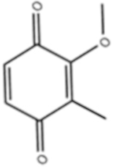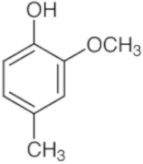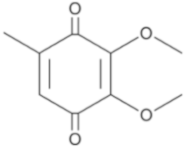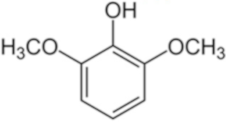Abstract
The poly-component composition of repugnatorial secretions isolated from Rhinocricus duvernoyi Kasrh 1981 eco-geographical populations, inhabiting in the eastern zone of Cuban archipelago, was analyzed using GC-MS. Were identified several benzoquinonoids and related derivatives, revealing the existence of a singular compositional heterogeneity at a geographical scale. The preliminary molecular-geographic mapping of the Cuban archipelago detailed the presence of 3 chemotypes in the east region. The work reports a structural-chromatographic molecular database containing the components of defensive secretions.
1. Introduction
Chemical-bioprospecting [1,2] is a conceptual, and methodological, tool of singular importance for the evaluation of biodiversity as a sustainable source of metabolites, polyfunctional molecular systems, and raw materials with high added value [3,4,5].
Progresses achieved in the field of structural and compositional studies of bioactive chemical compounds isolated from invertebrates, inhabiting in neotropical insular conditions, and their environmental interactions through metabolomics and chemogenomic, paving the way for strategical exploration of biodiversity in the search for potential compounds that are biologically active and have industrial utility [6,7,8,9].
Millipedes (Diplopoda), slow-motion detritivores, constitute one of the largest taxonomic groups on the planet, reaching up to 80,000 species [10,11], and one of the oldest invertebrate groups on Earth, dating back to the Silurian and Devonian [12].
Commonly known as a “thousand-legger” [13], it has been well established that they have an extraordinary biochemical weaponry against predators and parasites as a mean of defense [14,15,16]. Chemical ecology studies on the defensive secretions of millipedes have revealed a remarkable differentiation in the molecular composition of these secretions. These repugnatorial defensive bioactive secretions are poly-component molecular systems with a high degree of volatility, which are biosynthesized in specialized glands (ozadens) located in the segments (dorso-lateral part of the body) and discharged into the environment through ozopores when the individual is disturbed. These defensive secretions, or defense allomones, can constitute real molecular monsters due to their composition and sometimes are only mono-component mixtures [17,18]. The components of millipede allomones, mostly benzoquinonoids, esters, cyanogenic compounds, alkaloids, hydrocarbons, and oxygenated derivatives with a molecular weight varying between 80 and 580 Da, are different for each order, class, and family of millipedes, with compositional differences related to environmental and eco-geographical conditions, inter-species interactions, type of feeding, age, sex, ontogenetic developmental phase etc., indicating some evolutionary patterns in interspecific or intraspecific differences, and that they may, therefore, be useful as chemotaxonomic biomarkers [19,20].
The genus Rhinocricus (Spirobolida, Rhinocricidae) is widely distributed in the Cuban archipelago, and constitutes the major component of the insular edaphic biomass of Cuban terrestrial invertebrate biodiversity [21]. Independently of the observed morphological stasis, five species-subspecies of gen. Rhinocricus are identified: Rhinocricus duvernoyi, Rhinocricus maximus maximus, Rhinocricus suprenans, Rhinocricus maximus bartschi and Rhinocricus barbourin [22].
Continuing our research program on the applied chemical ecology of defensive secretions of millipedes inhabiting the insular neotropical region, the Cuban archipelago, this report describes the results of a GC-MS study on isolated repugnatorial ejections from Rhinocricus populations inhabiting the eastern region of Cuba.
The global strategy of chemical-prospecting, in sustainable and scalable conditions, for studying the defensive secretions of Rhinocricus populations, from the western zone of Cuban archipelago, has been described previously in [23].
2. Materials and Methods
2.1. General Procedures
All commercial reagents (KI, AgNO3, KOH, Na2SO4, picric acid, and oxalic acid) and solvents (ethyl ether, acetone, ethanol, methanol, chloroform, dichlomethane, and ethyl acetate) were purchased from Sigma-Aldrich/Merck Life Science (Darmstadt, Germany), and they were used without any further purification.
2.2. Determination of the Potential Presence of Cyanide
Determination of cyanide: Alkaline picrate reagent was prepared as follows: Test tubes with 2 mL of 2% KOH and 1 mL of picric acid: Na2CO3:H2O (1:5:200 v/w/v) were prepared. 3 Whatman No 1 papers, each with a dimension of 8 × 1 cm, were dipped into the alkaline picrate solution for 15 min. The picrate-impregnated papers were removed from the solution, air-dried, and used immediately for cyanide determination. In the case of HCN in the defensive secretion, the paper impregnated with alkaline picric acid gradually changes to orange-reddish color.
2.3. Gas Chromatography Coupled with Mass Spectrometry (GC-MS)
A Hewlett-Packard 6890 gas chromatograph (Palo Alto, CA, USA) with a 5973 quadrupole detection system (GC-MS) was used. The separations were carried out through a capillary column of Ultra 2 type (J & W Scientific, Folsom, CA, USA), 12 m long and 0.22 mm of internal diameter. A carrier gas was used, He, at a flow of 1 mL/min. Temperature ramp: 60 °C with increments of 10 °C/min up to 300 °C (isothermal 5 min). Run time 30 min. Injection volume 2 μL at a temperature of 280 °C, in split mode (1:10 ratio). The ionization source was IE at 70 eV operating at 230 °C. Acquisition mode: Full Scan. Range of m/z 40–700. The percentage of each chemical constituent was calculated by comparing the average peak area to the total areas.
2.4. Biological Material
Adult individuals (males) were collected in the following sites of the eastern eco-geographical zone of the Cuban Archipelago (3: San Miguel de Baga-Guáimaro, GPS: 21.428853, −77.328784; Rio Cauto-Bayamo, GPS: 20.531927, −76.926885; Baracoa-Guantánamo, GPS: 20.316253. −74.554577) during the months of July–August of 2019 and 2020. The specimens (1 individual per geographic collection area) were kept in the Organic Chemistry Laboratory of the Faculty of Science & Technology at Technical University of Esmeraldas, Ecuador (vouchers 004–006). The geographical zones where the collection and secretion extraction were performed are depicted in Figure 1.
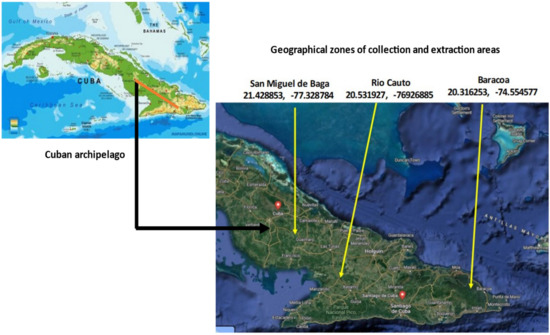
Figure 1.
Geographical zones of collection and extraction areas of defensive secretions from Rhinocricus sp. Population inhabiting in the easter zone of Cuban archipelago.
2.5. Extraction and Isolation
To obtain the defensive secretions, which have an intense reddish-brown coloration, the male individuals are stimulated mechanically in situ (in field conditions), over a Whatman 40 filter paper. The filter paper is extracted with diethyl ether (2 × 2 mL) and the unified extracts are concentrated to dryness and stored in a 1 mL Eppendorf vials protected from the light. To each vial, dichloromethane (0.7 mL) is added; then, the mixture is filtered through 0.45 μm frit, and injected into the GC-MS (20 μL).
3. Results and Discussion
The investigation of millipede repugnatorial secretions is a complex task. It necessitates a conceptual, and methodological, understanding of (1) global biological roles as mixed “polycomponent” molecular systems, (2) specific metabolic and synergistic functionality of each component of the studied defensive secretion, and (3) evolutionary and chemotaxonomic significance of each component and, also, of the total repugnatorial secretion, including inter-species relationships, as well as the definition of chemical-physical parameters defining repugnatorial action under given environmental conditions [24].
Given that only about 200 species of millipedes have been studied in terms of applied chemical ecology and chemical composition analysis, there is a significant challenge ahead. The goal is to gain a comprehensive, and systemic, structural-functional understanding of these repugnatorial secretions. Moreover, there is potential in harnessing these secretions as eco-friendly raw materials to develop new molecular entities for applications in medicine, pharmaceuticals, agrochemicals, vector control, and other related areas. Additionally, a proper evaluation of their chemo-taxonomic and evolutionary significance is vital.
The collected individuals (males) were gently treated using mechanical methods (hand pressure) to collect the defensive secretion, of a very noxious “phenolic” odor, under field conditions. This approach not only allowed for the in situ georeferencing of the geographical populations during collection, but also ensured minimal disturbance and irritation of the individual. No female or juvenile individuals were collected.
The preliminary study for the detection of cyanhydric acid (or CN−) did not report its presence in the defensive secretions collected at the three geographical points described above. Thin-layer chromatography, and chromogenic reactions (rhodamine + NH4OH) on SiO2 (AgNO3 + HOOC-COOH) plates, of the repugnatorial secretions collected in situ unequivocally established their multi-component structure, and the presence of quinonoid metabolites, such as phenols and benzoquinones.
The compositional-structural analysis, carried out by GC-MS, of the defensive secretions from millipede populations of the gen. Rhinocricus sp., which inhabit the eastern eco-geographical zone of the Cuban archipelago, isolated from three specific locations described above (see Figure 1), has revealed structural variations and interesting molecular patterns. The results of the GC-MS analysis are reported in Table 1.

Table 1.
Secondary metabolites identified, via GC-MS, in millipede defensive secretions isolated from eco-geographical populations under study.
GC-MS analysis of the extracts obtained from repugnatorial ejections detailed the presence of well-resolved six volatile, organic, benzoquinonoid, components.
The preliminary study of the repugnatorial secretions isolated from Rhinocricus populations inhabiting the eastern zone of the Cuban archipelago reveals that these secretions are poly-component systems. The majority of the defense allomones components are benzoquinonoids, comprising 50% substituted phenols and 34% polysubstituted benzoquinones. The miscellaneous compound constitutes 17% of the secretions, including a carbonyl derivative C-10 (decanal).
It should be noted that both, i.e., substituted phenols and poly-substituted 1,4-benzoquinones, as defense allomones, are widely distributed in terrestrial invertebrates and function as repugnatorial defensive molecular mechanism. The two major benzoquinoid components described: 2,3-dimethoxy-5-methyl-1,4-benzoquinone and 2-methoxy-3-methyl-1,4-benzoquinone, are also components of the defensive secretion of millipedes of the orders Spirobolida, Spirostreptida, and Julida, corroborating the significance of benzoquinonoids as molecular defenses in millipedes against predators and microbial pathogens. The identification of decanal, in the defensive secretion of Baracoa population, is the first report on the presence of an aliphatic aldehyde as a defense allomone in the neotropical insular region.
Work is currently underway to evaluate the antimicrobial activity of these repugnatorial secretions and to design eco-sustainable synthesis strategies to obtain new pharmacologically active molecular entities. The results will be published soon.
4. Conclusions
The compositional difference in the defensive secretions of populations of millipedes genus. Rhinocricus, that inhabit the eastern ecogeographic zone of the Cuban archipelago, is reported. Three different chemotypes for the genus Rhinocricus were found and decanal was identified, for the first time, in repugnatorial secretions of Spirobolida-Rhinocricidae millipedes in neotropical insular region. In previous works [23] have conducted studies on the composition of the defensive secretions of millipedes of the genus Rhinocricus that inhabit the western zone of the Cuban neotropical archipelago, demonstrating the significant molecular diversity among these defensive allomones. The present work provides a more comprehensive eco-geographical and systematic chemical perspective and enables the consideration of these molecular structures as potential chemotaxonomic biomarkers characteristics of these population.
Author Contributions
J.E.T.M.: conceptualization and methodology; C.B.V.: investigation and validation; X.L.G.C.: formal analysis and instrumentation; M.E.C.: formal analysis, investigation and project administration; M.T.C.P.: writing—review and editing, resources, and investigation. All authors have read and agreed to the published version of the manuscript.
Funding
This study was supported, in part, by the ministerial program support from Prometheus Project Ecuador “Proyecto Prometeo SENESCyT-UCE-09085066, Government of Republic of Ecuador, Chemical Bioprospecting of Tropical Biodiversity 2015–2017”, extended to 2018.
Institutional Review Board Statement
Not applicable.
Informed Consent Statement
Not applicable.
Data Availability Statement
Not applicable.
Acknowledgments
The authors would like to thank the Cuban colleagues who participated in the expeditions to collect the voucher specimens and isolate the defensive sections in situ. The authors, would like to thank the Multidisciplinary Research Laboratory (GIM) of the UTLVTE, Ecuador, for preserving the collected animals and providing the basic means of research.
Conflicts of Interest
The authors declare no conflict of interest. The Technical University of Esmeraldas, Ecuador, had no role in the design of the study; in the collection, analyses, or interpretation of data; in the writing of the manuscript, or in the decision to publish the results.
References
- Ramesha, B.T.; Gertsch, J.; Ravikanth, G.; Priti, V.; Ganeshaiah, K.N.; Uma, R. Biodiversity and chemo-diversity: Future perspectives in bioprospecting. Curr. Drug Targets 2011, 12, 1515–1530. [Google Scholar] [CrossRef] [PubMed]
- Srivastava, B.; Reddy, P.B. Recent Advances in Biodiversity Research, 1st ed.; International Multidisciplinary Research Foundation: Vijayawada, India, 2023; pp. 11–126. [Google Scholar]
- Upadhyay, S.K.; Singh, S.P. Bioprospecting of Plant Biodiversity for Industrial Molecules, 1st ed.; Wiley & Son: Hoboken, NJ, USA, 2021; pp. 7–430. [Google Scholar] [CrossRef]
- Sawarkar, A.; Sharma, K.K.; Gautam, V. Bioprospecting: Creating value for biodiversity. Pharma Innov. J. 2019, 8, 256–265. [Google Scholar]
- Santana, K.; Nascimento, L.D.D.; e Lima, A.L.; Damasceno, V.; Nahum, C.; Braga, R.C.; Lameira, J. Applications of Virtual Screening in Bioprospecting: Facts, Shifts, and Perspectives to Explore the Chemo-Structural Diversity of Natural Products. Front. Chem. 2021, 9, 662–688. [Google Scholar] [CrossRef] [PubMed]
- Tummanam, A.; Sutthisa, W.; Radchatawedchakoon, W.; Backeljau, T.; Pimvichai, P. Composition and Antimicrobial Activity of Defensive Secretions of the Giant Millipede Anurostreptus sculptus (Diplopoda, Spirostreptida, Harpagophoridae). Trop. Nat. Hist. 2023, 23, 42–51. [Google Scholar]
- Dixit, S.; Shukla, A.; Singh, V.; Upadhyay, S.K. Bioprospecting of Natural Compounds for Industrial and Medical Applications. Current Scenario and Bottleneck, Ch.3. In Bioprospecting of Plant Biodiversity for Industrial Molecules, 1st ed.; Upadhyay, S.K., Singh, S.P., Eds.; Wiley & Son: Hoboken, NJ, USA, 2021; pp. 53–71. [Google Scholar] [CrossRef]
- Bajorath, J. Computational approaches in chemogenomics and chemical biology: Current and future impact on drug discovery. Expert Opin. Drug Discov. 2008, 3, 1371–1376. [Google Scholar] [CrossRef] [PubMed]
- Saldivar-Gonzalez, F.I.; Aldas-Bulos, V.D.; Medina-Franco, J.L.; Plisson, F. Natural product drug discovery in the artificial intelligence era. Chem. Sci. 2022, 13, 1526–1546. [Google Scholar] [CrossRef] [PubMed]
- Sierwald, P.; Bond, J.E. Current status of the myriapod class Diplopoda (Millipedes): Taxonomic diversity and phylogeny. Annu. Rev. Entomol. 2007, 52, 401–420. [Google Scholar] [CrossRef] [PubMed]
- Enghoff, H.; Golovatch, S.; Short, M.; Stoev, P.; Wesener, T. Diplopoda–Taxonomic overview. In The Myriapoda 2. Treatise on Zoology—Anatomy, Taxonomy, Biology, 1st ed.; Minelli, A., Ed.; Brill: Leiden, The Netherlands, 2016; Volume 2, pp. 363–453. [Google Scholar]
- Garwood, R.; Edgecombe, G. Early terrestrial animals, evolution and uncertainty”. Evol. Educ. Outreach 2011, 4, 489–501. [Google Scholar] [CrossRef]
- Marek, P.E.; Buzatto, B.A.; Shear, W.A.; Means, J.C.; Black, D.G.; Harvey, M.S.; Rodriguez, J. The first true millipede—1306 legs long. Sci. Rep. 2021, 11, 23126. [Google Scholar] [CrossRef] [PubMed]
- Eisner, T.; Alsop, D.; Hicks, K.; Meinwald, J. Defensive secretions of millipedes. In Arthropod Venoms, 1st ed.; Bettini, S., Ed.; Handbook of Experimental Pharmacology; Springer: Berlin/Heidelberg, Germany, 1978; Volume 48, pp. 41–72. [Google Scholar] [CrossRef]
- Bodner, M.; Vagalinski, B.; Makarov, S.E.; Antić, D.Z.; Vujisić, L.V.; Leis, H.J.; Raspotnig, G. “Quinone millipedes” reconsidered: Evidence for a mosaic-like taxonomic distribution of phenol-based secretions across the Julidae. J. Chem. Ecol. 2016, 42, 249–258. [Google Scholar] [CrossRef] [PubMed]
- Shear, W.A. The chemical defenses of millipedes (Diplopoda): Biochemistry, physiology and ecology. Biochem. Syst. Ecol. 2015, 61, 78–117. [Google Scholar] [CrossRef]
- Ilić, B.; Dimkić, I.; Unković, N.; Ljaljević, G.; Vukojević, M.; Vujisić, L.; Tešević, V.; Stanković, S.; Makarov, S.; Lučić, L. Millipedes vs. pathogens: Defensive secretions of some julids (Diplopoda: Julida) as potential antimicrobial agents. J. Appl. Entomol. 2018, 142, 775–791. [Google Scholar] [CrossRef]
- Ilić, B.; Unković, N.; Ćirić, A.; Glamočlija, J.; Ljaljević, G.; Raspotnig, G.; Bodner, M.; Vukojević, J.; Makarov, S. Phenol-based millipede defense: Antimicrobial activity of secretions from the Balkan endemic millipede Apfelbeckia insculpta (L. Koch, 1867) (Diplopoda: Callipodida). Sci. Nat. 2019, 106, 37. [Google Scholar] [CrossRef] [PubMed]
- Deml, R.; Huth, A. Benzoquinones and hydroquinones in defensive secretions of tropical millipedes. Naturwissenschaften 2000, 87, 80–82. [Google Scholar] [CrossRef] [PubMed]
- Ramawat, K.G. An Introduction to Biodiversity and Chemotaxonomy. In Biodiversity and Chemotaxonomy, 1st ed.; Ramawat, K.G., Ed.; Springer Nature: Cham, Switzerland, 2019; Volume 24, pp. 1–14. [Google Scholar] [CrossRef]
- Martínez-Muñoz, C.A. Asignación de localidad tipo a Rhinocricus duvernoyi (Karsch, 1881) (Diplopoda: Spirobolida: Rhinocricidae). Boletín Soc. Entomológica Aragonesa 2014, 55, 320–322. [Google Scholar]
- Guzmán Menéndez, J.M. The Cuban Archipelago. Biological diversity, ecosystems and landscapes. In Family Farms and the Conservation of Agrobiodiversity in Cuba, 1st ed.; Paleo, U., Castiñeiras, L., Eds.; Taylor & Francis Group: London, UK, 2023; pp. 18–25. [Google Scholar]
- Tacoronte Morales, J.E.; Cabrera Pedroso, M.T.; Diplodomica, I. Chemical Composition of Repugnatorial Secretions of Cuban Endemic Millipede gen. Rhinocricus sp. Proceedings 2019, 41, 73. [Google Scholar] [CrossRef]
- Rodriguez, J.; Jones, T.H.; Sierwald, P.; Marek, P.E.; Shear, W.A.; Brewer, M.S.; Kocot, K.M.; Bond, J.E. Step-wise evolution of complex chemical defenses in millipedes: A phylogenomic approach. Sci. Rep. 2018, 8, 3209. [Google Scholar] [CrossRef] [PubMed]
Disclaimer/Publisher’s Note: The statements, opinions and data contained in all publications are solely those of the individual author(s) and contributor(s) and not of MDPI and/or the editor(s). MDPI and/or the editor(s) disclaim responsibility for any injury to people or property resulting from any ideas, methods, instructions or products referred to in the content. |
© 2023 by the authors. Licensee MDPI, Basel, Switzerland. This article is an open access article distributed under the terms and conditions of the Creative Commons Attribution (CC BY) license (https://creativecommons.org/licenses/by/4.0/).

